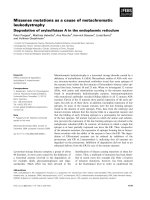Báo cáo khoa hoc:" Selection of as grandparental combinations a procedure designed to make use of dominance genetic effects" pot
Bạn đang xem bản rút gọn của tài liệu. Xem và tải ngay bản đầy đủ của tài liệu tại đây (571.75 KB, 11 trang )
Original
article
Selection
of
grandparental
combinations
as
a
procedure
designed
to
make
use
of
dominance
genetic
effects
Miguel
A.
Toro
CIT-INIA,
Area
de
Mejora
Genética
Animal,
Carretera
La
Coruña
Km.7,
28040
Madrid,
Spain
(Received
2
March
1998;
accepted
27
May
1998)
Abstract -
A
general
procedure
called
selection
of
grandparental
combinations
(SGPC)
is
presented,
which
allows
one
to
use
dominance
genetic
effects.
The
method
assumes
that
there
are
two
types
of
matings:
either
to
breed
the
population
or
to
obtain
commercial
animals.
The
idea
is
to
select
grandparental
combinations
such
that
the
overall
genetic
merit
of
future
grandoffspring
which
constitute
the
commercial
animals
is
maximized.
Two
small
computer
simulated
examples
are
analysed
assuming
either
a
infinitesimal
genetic
model
or
that
QTL
controlling
the
trait
are
known.
©
Inra/Elsevier,
Paris
selection
of
grandparental
combinations
/
dominance
variance
/
mating
strate-
gies
Résumé -
Sélection
de
combinaisons
de
grands-parents
comme
une
procédure
pour
utiliser
les
effets
de
dominance
génétique.
On
présente
une
procédure
générale
appelée
sélection
de
combinaisons
de
grands-parents
(SGPC),
qui
permet
l’utilisation
des
effets
de
dominance
génétique.
La
méthode
suppose
qu’il
y
a
deux
types
d’accouplements,
l’un
pour
propager
la
population,
l’autre
pour
l’obtention
des
animaux
commerciaux.
L’objectif
est
de
sélectionner
les
combinaisons
de
grands-
parents
de
telle
façon
que
le
mérite
génétique
global
des
futurs
petit-fils,
qui
cons-
tituent
les
animaux
commerciaux,
soit
maximisé.
Deux
petits
exemples
de
simulation
sur
ordinateur
sont
analysés,
l’un
supposant
le
modèle
génétique
infinitésimal,
et
l’autre
introduisant
des
QTL
qui
contrôlent
le
caractère.
©
Inra/Elsevier,
Paris
sélection
de
combinaisons
de
grands-parents
/
variance
de
dominance
/
stratégies
d’accouplement
E-mail:
1.
INTRODUCTION
Breeding
programmes
for
economically
important
traits
are
based
on
select-
ing
as
parents
for
the
next
generation
the
individuals
with
highest
genetic
merit
estimated
by
mixed model
methodology.
However,
in
the
near
future,
molecu-
lar
information
will
be
integrated
into
mixed
models
to
achieve
the
maximum
improvement.
If
the
loci
affecting
a
quantitative
trait
(QTL),
were
known,
it
would
be
possible
to
directly
select
specific
alleles,
or
if
genetic
markers
linked
to
QTL
were
detected,
they
could
also
be
used
in
marker-assisted
selection.
In
any
case,
profit
from
dominance
genetic
effects
in
breeding
programmes
can
only
be
obtained
when
final
commercial
animals
are
the
product
of
matings
other
than
those
involved
in
the
maintenance
of
the
breeding
population.
In
a
large
number
of
domestic
species,
the
final
product
is
the
result
of
two-
way,
three-way
or
rotational
crossbreeding
among
breeds
or
strains
that
are
maintained
separately.
In
this
context,
selection
is
independently
carried
out
in
each
parental
population
and,
in
addition,
the
value
of
the
cross
may
increase
as
a
result
of
heterosis.
An
exception
to
this
practice
is
the
reciprocal-recurrent
selection
scheme
(RRS)
!1!,
whose
merits
relative
to
pure-line
selection
(PLS)
have
been
reviewed
by
Wei
and
van
der
Steen
!14!.
Several
authors
have
suggested
that
although
selection
should
be
carried
out
on
estimated
additive
breeding
values,
animals
used
for
commercial
production
should
be
the
product
of
planned
matings
which
maximize
the
overall
(additive
plus
dominance
effects)
genetic
merit
of
the
offspring
[4,
8].
More
recently,
Toro
[12]
claimed
that
dominance
genetic
variance
can
also
be
exploited
in
a
closed
population,
as
long
as
different
mating
systems
are
applied
for
providing
breeding
commercial
animals.
In
this
note,
we
present
a
more
general
procedure,
i.e.
selection
of
grand-
parental
combinations
(SGPC),
as
proposed
by
Toro
!13!,
which
is
not
restricted
to
the
progeny
test
scheme.
Moreover,
SPGC
benefits
from
the
use
of
mixed
model
methodology,
which
is
considered
as
the
method
of
choice
for
genetic
evaluation
in
animal
breeding.
2.
THEORY
The
methodology
suggested
by
Toro
[12]
basically
consists
in
making
two
different
types
of
matings
in
the
framework
of
a
progeny
test
scheme:
a)
minimum
coancestry
matings
to
obtain
commercial
animals
that
will
also
be
used
for
estimating
breeding
values
of
nucleus
animals;
and
b)
maximum
coancestry
matings
from
which
the
population
will
be
propagated.
Simulation
results
showed
that
the
superiority
of
this
new
method
over
the
standard
progeny
test
depends
on
the
genetic
architecture
of
the
trait
and
that
it
is
especially
effective
if
there
is
overdominance
or
if
there
are
unfavourable
recessive
alleles
at
low
frequencies.
This
method
has
two
main
limitations.
First,
it
is
not
optimized
with
respect
to
the
proportion
of
matings
among
relatives
both
to
obtain
commercial
animals
and
to
propagate
the
population.
Second,
it
is
limited
to
a
progeny
test
breeding
scheme.
The
method
proposed
in
the
present
paper,
called selection
of
grandparental
combinations
(SGPC),
is
not
restricted
to
a
progeny
test
scheme
and
it is
aimed
at
optimizing
the
proportion
of
matings
among
relatives
in
both
the
commercial
and
the
breeding
population.
Consider,
for
the
sake
of
simplicity,
a
population
of
three
males
(1,
2,
3)
and
three
females
(4,
5,
6).
The
objective
is
to
select
two
mating
pairs
to
propagate
the
population
from
the
nine
potential
ones
shown
in
table
L
At
some
future
time,
the
commercial
animals
will
be
the
grandoffspring
of
the
individuals
considered
and,
therefore,
the
progeny
of
one
of
the
18
potential
grandparental
combinations,
assuming
that
each
male
can
only
be
mated
with
one
female
(table
7).
Thus,
we
should
select
the
combination
which
maximizes
the
expected
value
of
the
overall
genetic
merit
of
the
future
commercial
animals.
If,
for
example,
the
expected
genetic
merit
of
the
grandoffspring
of
(1
x
4)
x
(2
x
6)
is
the
highest,
we
should
select
mating
pairs
1x4
4 and
2
x
6
for
the
propagation
of
the
population.
The
genetic
values
of
these
expected
grandoffspring
could
be
predicted
using
mixed model
methodology
including
dominance
and
inbreeding
genetic
effects.
An
intuitive
interpretation
would
be
as
follows.
If,
for
example,
a
trait
is
controlled
by
a
biallelic
locus
showing
overdominance,
the
best
grandparental
combination
for
obtaining
future
commercial
animals
would
be
(AA
x
AA)
x
(aa
x
aa),
because
it
produces
heterozygous
Aa
grandoffspring.
Obviously,
mating
pairs
AA
x
AA
and
aa
x
aa
should
be
chosen
to
propagate
the
population.
3.
SIMULATION
Because
of
the
rather
intuitive
justification
of
the
method
given
above,
the
performance
of
the
newly
proposed
method
was
checked
by
computer
simulation
assuming
either
an
infinitesimal
model
or
a
model
based
on
known
genetic
loci.
3.1.
Breeding
scheme
Selection
was
carried
out
over
six
generations
following
closely
the
scheme
presented
in
table
I
but
considering
a
population
of
32
candidates
(16
males
and
16
females)
instead
of
six
candidates
(three
males
and
three
females).
Each
generation,
four
combinations
of
potential
grandparents
(eight
mating
pairs)
were
selected
according
to
the
predicted
genetic
merit
of
their
grandoffspring.
Although
the
most
appropriate
technique
for
selecting
the
best
grandparental
combinations
would
be
linear
programming,
a
simpler
and
computationally
faster
strategy
that
sequentially
chooses
the
best
available
combinations
was
used
!9!.
As
indicated
by
this
author,
this
strategy
is
generally
close
to
optimal.
The
new
method
was
compared
with
a
standard
selection
method
in
which
potential
grandparents
were
selected
according
to
their
average
predicted
additive
genetic
value.
The
number
of
replicates
was
200
for
the
infinitesimal
genetic
model
and
100
for
the
finite
loci
model.
3.2.
Infinitesimal
genetic
model
The
total
phenotypic
effect
of
an
individual,
y,
was
simulated
as
where
a
is
the
additive
value,
b and
F
are
the
inbreeding
depression
and
the
coefficient
of
inbreeding
of
the
individual,
d
the
dominance
effect
and
e
an
environmental
random
deviate.
The
dominance
effect,
ignoring
inbreeding,
was
simulated
as
its
sire
x
dam
combination
effect
plus
mendelian
sampling
[7]
where
fS,D
represents
the
average
dominance
effect
of
many
hypothetical
full-
sibs
produced
by
the
individual’s
sire
S
and
dam
D,
and
6 is
the
individual’s
deviation
from
the
sire
x
dam
subclass
effect.
Variances
are
V(fs,
D)
=
0.25
VD
and
V (6)
=
0.75
VD,
where
VD
is
the
dominance
variance.
Genetic
evaluation
was
carried
out
using
only
phenotypic
information
from
breeding
individuals
in
current
and
previous
generations
to
estimate
additive
and
dominance
effects.
First,
the
following
statistical
model
was
used
where
yi
is
the
phenotypic
value
of
animal
i,
b
is
the
inbreeding
depression
(assumed
to
be
known),
and
ai
and
di
are
additive
and
dominance
effects
of
animal
i,
respectively.
Other
possible
fixed
effects
such
as
generation
effect
were
ignored
for
simplicity.
Now,
if
m
is
the
vector
of
genetic
merit
m
=
a
+
d,
the
BLUP
of
m
is
the
solution
of
equations
where
M
=
(A
VA
+
D
VD
)/V
E,
VE
being
the
environmental
variance.
The
expected
additive
plus
dominance
genetic
merit
of
the
grandoffspring
of
a
grandparent
combination
(i
x
j)
x
(k
x
l)
was
calculated
using
[6]
where
Gij
kl
is
the
covariance
between
the
genetic
merit
of
the
grandoffspring
of
the
grandparental
combination
(i
x j)
x
(k
x
l)
and
the
vector
of
genetic
merits
m,
computed
from
the
additive
and
dominance
relationship
matrices.
Finally,
the
predicted
total
genetic
merit
was
corrected
for
the
inbreeding
depression.
The
standard
procedure
is
based
on
a
genetic
evaluation
using
the
same
model
(including
dominance)
as
for
the
proposed
method.
Different
situations
with
the
same
genetic
parameters
VA
=
3.25,
VD
=
6.55
and
VE
=
6.55
but
increasing
levels
of
inbreeding
depression
were
considered.
3.2.
Finite
loci
model
The
trait
of
interest
was
simulated
as
controlled
by
100
independent
loci
with
equal
effects.
Genotypic
values
at
each
one were
1,
d, -1
for
the
allelic
combinations
BB,
Bb
and
bb,
respectively.
Values
of
d
=
0,
0.25,
1,
-1
and
1.5
were
considered
representing
different
degrees
of
recessivity
of
the
unfavourable
allele.
The
initial
frequency
of
the
b
allele
was
0.20.
A
two-loci
model
with
epistatic
interaction
was
also
tested.
The
genotypic
values
are
given
in
table
Il
assuming
additive
x
additive
and
diminishing
epis-
tasis
!2!.
Fifty
pairs
of
such
loci
were
simulated
with
initial
frequencies
of alleles
bandcof0.8.
In
the
SGPC
method,
the
expected
overall
genetic
merit
of
the
grand-
offspring
of
a
grandparental
combination
(i
x
j)
x
(k
x
l)
was
predicted
calculating
the
genetic
composition
of the
grandoffspring
from
simple
mendelian
rules. In
the
standard
method, the
breeding
values
of the
potential
grandparents
were
also
calculated
in
the
same
way.
4. RESULTS
4.1.
Infinitesimal
genetic
model
The
values
of
the
genetic
mean
of
the
trait
during
the
first
six
generations
of
selection,
using
the
standard
procedure
and
the
new
method
are
presented
in
table
III,
together
with
the
mean
inbreeding
coefficient for
both
the
commercial
and
the
breeding
populations.
Strictly
speaking,
the
performance
of
the
breed-
ing
population
is
an
observed
value,
while
the
performance
of
the
commercial
population
is
an
expected
value
that
will
be
realized
with
a
one-generation
delay.
The
cases
A,
B,
C
and
D
in
table
III
refer
to
different
situations
with
the
same
genetic
variance
components
but
increasing
levels
of
inbreeding
depression.
This
is
possible
in
a
genetical
infinitesimal
model
where,
unlike
the
typical
biallelic
genetic
model,
inbreeding
depression
and
dominance
variance
are
independent.
As
shown
in
table
III
the
new
method
achieved
the
objective
of
obtaining
superior
performance
of
the
commercial
population
in
all
cases.
This
superiority
was
attained
by
inducing
some
matings
among
relatives
in
the
breeding
population,
in
order
to
profit
from
dominance.
Consequently,
the
performance
of
the
breeding
population
was
worse
with
SGPC
when
inbreeding
depression
was
larger,
as
in
cases
C
and
D.
Nevertheless,
with
SGPC,
the
inbreeding
coefficient
of
commercial
animals
is
automatically
adjusted
depending
on
the
magnitude
of
inbreeding
depression.
In
case
A,
inbreeding
depression
is
not
important
and
therefore,
a
considerable
rate
of
inbreeding
is
allowed,
whereas
in
case
C,
the
magnitude
of
inbreeding
depression
imposes
a
stronger
restriction.
Obviously,
in
case
D,
the
lower
inbreeding
in
the
commercial
population
is
the
factor
that
determines
its
performance.
In
cases
A-D,
it
has
been
assumed
that
only
the
performance
of
the
commer-
cial
population
is
economically
valuable,
but
SGPC
could
easily
accommodate
selection
for
both
commercial
and
breeding
population
performances.
Case
E
of
table
III
is
the
same
as
case
D
except
that
the
objective
of
selection
is
a
combination
of
the
expected
genetic
merit
of
the
commercial
grandoffspring
and
the
expected
genetic
merit
of
candidates
for
selection
in
the
next
gener-
ation,
giving
the
same
weight
to
both
expected
values.
Although
this
equal
weighting
is
arbitrary,
it
highlights
the
fact
that
both
commercial
and
breeding
population
performances
could
be
included.
The
results
indicate
that
the
lower
performance
of
the
commercial
population
is
compensated
by
the
superior
per-
formance
of
the
breeding
population.
4.2.
QTL
identified
Table
IV
shows
that
the
results
with
the
defined
genetic
model
are
similar
to
those
of
the
infinitesimal
one.
With
SGPC,
the
performance
of
the
commercial
animals
is
always
superior,
especially
in
the
case
of
overdominance
or
diminish-
ing
epistasis.
However,
as
a
consequence
of
matings
among
relatives
induced
in
the
breeding
population,
the
performance
of
this
population
was
worse
when
inbreeding
depression
was
present.
On
the
contrary,
with
SGPC,
the
inbreeding
commercial
population
is
lower
than
with
the
standard
method,
and
in
the
cases
of
complete
dominance
and
overdominance,
the
avoidance
of
inbreeding
is
maximum.
However,
in
the
case
of
d
=
-1
the
SGPC
induces
inbreeding
in
both
the
commercial
and
the
breeding
population,
because
in
this
case
inbreeding
in-
creases
the
genetic
mean
and
therefore
both
populations
have
better
perfor-
mance
than
with
the
standard
method.
And
if
inbreeding
depression
is
absent,
as
in
the
case
of
additive
x
additive
epistasis
[2]
or
when
positive
and
nega-
tive
effects
of
inbreeding
are
cancelled
because
at
half
of
the
loci
d
=
1
and
at
the
other
half
d
=
-1
(case
G,
table
IT!,
the
optimal
level
of
inbreeding
is
automatically
adjusted.
5.
DISCUSSION
Although
the
idea
of
using
deliberate
inbreeding
in
selection
programmes
is
generally
disfavoured
in
animal
breeding,
several
authors
have
indicated
that
a
reappraisal
of
the
subject
is
needed
[5,
12].
Inbreeding
has
two
opposite
effects.
It
increases
selection
response
because
it
allows
the
accumulation
of
dominance
effects
but
it
also
decreases
genetic
mean
due
to
inbreeding
depres-
sion.
The
SGPC
method
proposed
here
is
intended
to
take
simultaneously
into
account
both
aspects
of
the
problem.
The
idea
is
that
we
should
select
grand-
parental
combinations
such
that
the
overall
genetic
merit
of
future
commercial
grandoffspring
will
be
maximum.
In
this
way,
the
proportion
of
matings
among
relatives
is
optimized
both
to
obtain
commercial
animals
and
to
propagate
the
population.
The
main
aim
of
the
present
paper
has
been
to
propose
this
new
procedure,
which
appears
to
be
a
general
method
of
utilizing
additive
and
dominance
effects.
The
method
has
been
checked
by
computer
simulation
of
a
breeding
scheme
which
was
unrealistically
small
in
order
to
achieve
computational
feasibility
and
assumed
an
unrealistically
high
value
of
the
dominance
variance
(twice
the
additive
variance)
in
order
to
magnify
the
difference
between
the
methods.
Despite
this
large
assumed
variance,
the
improvement
was
less
than
15
%
in
cases
B and
C
(table
III).
This
casts
some
doubt
on
the
practical
advantages
of
the
new
method
and
more
work
remains
to
be
carried
out
simulating
more
practical
situations
of
current
nuclei
of
selection
including
the
cost
associated
with
inbreeding depression
of
the
breeding
population
and
specifying
the
structure
of
dissemination
of
genetic
progress.
But
two
facts
should
be
kept
in
mind.
First,
recent
developments
have
allowed
computations
with
models
including
dominance
[10]:
this
has
created
the
possibility
of
obtaining
a
benefit
from
such
evaluation
even
if
it
is
small.
Second,
the
method
could
also
be
generalized
to
include
multibreed
situations.
In
crossbreeding
the
method
will
optimize
the
matings
to
be
made
in
pure
breeds
in
order
to
achieve
maximum
profit
from
commercial
crossbred
grandoffspring.
The
new
method
has
some
analogies
with
reciprocal-recurrent
selection.
Both
methods
rely
on
the
crucial
distinction
between
commercial
and
breeding
populations.
But
RRS
begins
with
two
populations,
and
an
essential
pre-
requisite
is
that
there
should
be
some
difference
in
gene
frequency
between
the
two
lines
at
the
beginning
!1!.
The
start
of
SGPC
is
a
closed
population
and
any
subsequent
subdivision
that
can
occur
in
the
breeding
population
will
be
a
consequence
of
the
selection
process
and
will
depend
on
the
genetic
basis
of
the
selected
trait.
Some
theoretical
and
estimation
problems
remain
if
additional
phenotypic
information
is
used.
In
the
present
paper
evaluation
is
based
only
on
infor-
mation
coming
from
the
nucleus
but
it
could
be
improved
if
information
from
commercial
animals
of
previous
generations
might
be
included.
We
have
also
used
a
straightforward
infinitesimal
model
that
includes
dominance
variance
and
that
accounts
for
the
average
effect
of
inbreeding
on
the
mean
by
including
the
inbreeding
coefficient
as
a
covariate.
The
value
of
this
approach
has
been
discussed
by
de
Boer
and
van
Arendonk
!3!,
but
it
is
clear
that
for
a
detailed
un-
derstanding
of
how
the
SGPC
method
is
working
a
more
sophisticated
model
for
simulating
and
analysing
the
data
is
needed.
The
best
candidate
is
the
model
proposed
by
Smith
and
Maki-Tanila
!11!,
which
considers
the
reduction
of
base
dominance
variance,
the
increase
in
dominance
variance
of
completely
inbred
individuals
and
the
covariance
among
additive
and
dominance
effects
with
inbreeding.
The
present
study
has
additional
limitations
requiring
further
research.
The
properties
of
SGPC
in
the
medium
and
long
term
have
not
been
investigated
but
it
can
be
conjectured
that
the
additive
variance
in
the
long
term
will
be
reduced,
since
the
method
imposes
some
inbreeding
in
the
breeding
population.
Furthermore,
computation
could
also
be
a
limiting
factor:
with
N
grandparents
of
each
sex,
there
will
be
N4
grandparental
combinations.
The
present
study
has
shown
that
dominance
genetic
effects
can
be
accumulated
by
adequate
planning
of
selection
and
mating
policy.
REFERENCES
[1]
Comstock
R.E.,
Robinson
H.R.,
Harvey
P.B.,
A
breeding
procedure
designed
to
make
maximum
use
of
both
general
and
specific
combining
ability,
Agronomy
J.
41
(1949)
360-367.
[2]
Crow
J.F., Kimura
M.,
An
introduction
to
population
genetics
theory,
Harper
&
Row,
New
York,
1970.
[3]
De
Boer
I.J.M.,
Van
Arendok
J.A.M.,
Prediction
of additive
and dominance
effects
in
selected
and
unselected
populations
with
inbreeding,
Theor.
Appl.
Genet.
84
(1992)
451-459.
[4]
DeStefano
A.L.,
Hoeschele
I.,
Value
of
including
dominance
genetic
merit
in
mating
progress,
J.
Dairy
Sci.
75
(1992)
1680-1690.
[5]
Dickerson
G.E.,
Lindhé
N.B.H.,
Inbreeding
and
heterosis
in
animals,
in:
Pol-
lack
E.,
Kempthorne
0.,
Bailey
Jr.
(Eds.),
Proceedings
of
the
International
Confer-
ence
on
Quantitative
Genetics,
Iowa
State
University
Press,
1977,
pp.
323-342.
[6]
Henderson
C.R.,
Best
linear
unbiased
prediction
of
nonadditive
genetic
merit
in
mating
programs,
J.
Dairy
Sci.
84
(1985)
451-459.
[7],
Hoeschele
I.,
Van
Raden
P.M.,
Rapid
inversion
of
dominance
relationship
matrices
for
noninbred
populations
by
including
sire
x
dam
subclass
effects,
J.
Dairy
Sci.
74
(1991)
557-569.
[8]
Jansen
G.B.,
Wilton
J.W.,
Selecting
mating
pairs
with
linear
programming
techniques,
J.
Dairy
Sci.
68
(1985)
1302-1305.
[9J
Kinghorn
B.,
On
computing
strategies
for
mate
allocation,
J.
Anim.
Breed.
Genet.
104
(1987)
12-22.
[10]
Misztal
I.,
Lawlor
T.J.,
Gengler
N.,
Relationships
among
estimates
of
in-
breeding
depression,
dominance
and
additive
variance
for
linear
traits
in
Holsteins,
Genet.
Sel.
Evol.
29
(1997)
319-32Q.
!11!
Smith
S.P.,
Maki-Tanila
A.,
Genotypic
covariance
matrices
and
their
inverses
for
models
allowing
dominance and
inbreeding,
Genet.
Sel.
Evol.
22
(1990)
65-91.
[12]
Toro
M.,
A
new
method
aimed
at
using
the
dominance
variance
in
closed
breeding
populations,
Genet.
Sel.
Evol.
25
(1993)
63-74.
[13]
Toro
M.A.,
The
utilization
of
dominance
genetic
effects
in
selection
schemes,
in:
Proceedings
of
the
5th
World
Congress
on
Genetics
Applied
to
Livestock
Produc-
tion,
Guelph,
7-12
August
1994,
University
of
Guelph,
Canada,
1994, 262-65.
[14]
Wei
M., Van
der
Steen
H.A.M., Comparison
of reciprocal
recurrent
selection
with
pure-line
selection
systems
in
animal
breeding
(a
review),
Anim.
Breed.
Abstr.
59
(1991)
281-298.









